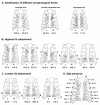Variety of transversus thoracis muscle in relation to the internal thoracic artery: an autopsy study of 120 subjects
- PMID: 21272314
- PMCID: PMC3037302
- DOI: 10.1186/1749-8090-6-11
Variety of transversus thoracis muscle in relation to the internal thoracic artery: an autopsy study of 120 subjects
Abstract
Background: The transversus thoracis muscle is a thin muscular layer on the inner surface of the anterior thoracic wall that is always in concern during harvesting of the internal thoracic artery. Because the muscle is poorly described in the surgical literature, the aim of the present study is to examine in details its variations.
Methods: The data was obtained at standard autopsies of 120 Caucasian subjects (Bulgarians) of both sexes (97 males and 23 females), ranging in age from 18 to 91 years (mean age 52.8 ± 17.8 years). The transversus thoracis morphology was thoroughly examined on the inner surface of the chest plates collected after routine incisions.
Results: An overall examination revealed that in majority of cases the transversus thoracis slips formed a complete muscular layer (left - 75.8%, right - 83.3%) or some of the slips (left - 22.5%, right - 15%) or all of them (left - 1.7%, right - 1.7%) were quite separated. Rarely (left - 3.3%, right - 5.8%), some fibrous slips of the transversus thoracis were noted. In 55.8% of the cases there was left/right muscle symmetry; 44.2% of the muscles were asymmetrical. Most commonly, the highest muscle attachment was to the second (left - 53.3%, right - 37.5%) or third rib (left - 29.2%, right - 46.7%). The sixth rib was the most common lowest attachment (left - 94.2%, right - 89.2%). Most frequently, the muscle was composed of four (left - 31.7%, right - 44.2%) or fifth slips (left - 53.3%, right - 40.8%).
Conclusions: This study provides detailed basic information on the variety of the transversus thoracic muscle. It also defines the range of the clearly visible, uncovered by the muscle part of the internal thoracic artery and the completeness of the muscular layer over it. The knowledge of these peculiar muscle-arterial relations would definitely be beneficial to cardiac surgeon in performing fast and safe arterial harvesting.
Figures
Similar articles
-
Avoiding the Internal Mammary Artery During Parasternal Blocks: Ultrasound Identification and Technique Considerations.J Cardiothorac Vasc Anesth. 2021 Jun;35(6):1594-1602. doi: 10.1053/j.jvca.2020.11.007. Epub 2020 Nov 16. J Cardiothorac Vasc Anesth. 2021. PMID: 33293216
-
[The internal thoracic blood vessels (internal thoracic arteries and veins) and their practical significance].Srp Arh Celok Lek. 1996 Mar-Apr;124(3-4):58-61. Srp Arh Celok Lek. 1996. PMID: 9102819 Serbian.
-
Surgical anatomy of the internal thoracic artery.Ann Thorac Surg. 1997 Oct;64(4):1041-5. doi: 10.1016/s0003-4975(97)00720-0. Ann Thorac Surg. 1997. PMID: 9354524
-
[The anterolateral structures of the neck and trunk].Rev Med Chir Soc Med Nat Iasi. 1996 Jan-Jun;100(1-2):69-74. Rev Med Chir Soc Med Nat Iasi. 1996. PMID: 9455400 Review. Romanian.
-
Transversus Thoracis Muscle Plane Block.Biomed Res Int. 2019 Jul 7;2019:1716365. doi: 10.1155/2019/1716365. eCollection 2019. Biomed Res Int. 2019. PMID: 31360703 Free PMC article. Review.
Cited by
-
Muscles and Central Neural Networks Involved in Breathing: State of the Art.Cureus. 2025 Mar 15;17(3):e80599. doi: 10.7759/cureus.80599. eCollection 2025 Mar. Cureus. 2025. PMID: 40091907 Free PMC article. Review.
-
Osteopathic Palpation of the Heart.Cureus. 2021 Mar 30;13(3):e14187. doi: 10.7759/cureus.14187. Cureus. 2021. PMID: 33816036 Free PMC article. Review.
-
Sternalis muscle: an underestimated anterior chest wall anatomical variant.J Cardiothorac Surg. 2011 May 16;6:73. doi: 10.1186/1749-8090-6-73. J Cardiothorac Surg. 2011. PMID: 21575244 Free PMC article.
-
Perioperative analgesia during thymectomy via median sternotomy : Ultrasound-guided bilateral parasternal block.Anaesthesist. 2019 Dec;68(12):848-851. doi: 10.1007/s00101-019-00700-w. Epub 2019 Nov 25. Anaesthesist. 2019. PMID: 31768562 English.
-
Chest pain in patients with COPD: the fascia's subtle silence.Int J Chron Obstruct Pulmon Dis. 2018 Apr 12;13:1157-1165. doi: 10.2147/COPD.S156729. eCollection 2018. Int J Chron Obstruct Pulmon Dis. 2018. PMID: 29695899 Free PMC article. Review.
References
-
- Durairaj M, Buxton B. In: Arterial Grafting for Coronary Artery Bypass Surgery. 2. He G-W, editor. Berlin, Heidelberg: Springer; 2006. Internal thoracic artery grafting; pp. 89–147. full_text.
-
- Góngora E, Sundt TM. , III. In: Cardiac Surgery in the Adult. 3. Cohn LH, editor. New York: McGraw Hill Medical; 2008. Myocardial revascularization with cardiopulmonary bypass; pp. 599–631.
-
- Moore KL. Clinically Oriented Anatomy. 3. Baltimore: Williams and Wilkins; 1992. p. 51.
-
- Salmons S. In: Gray's Anatomy. 38. Williams PL, Bannister LH, Berry M, Collins P, Dyson M, Dussek JE, Ferguson MWJ, editor. Edinburgh: Churchill Livingstone; 1995. Muscle; p. 815.
-
- Hyrtl J. Lehrbuch der Anatomie des Menschen. 18. Wien: Wilhelm Braumüller; 1885. p. 474.
Publication types
MeSH terms
LinkOut - more resources
Full Text Sources



